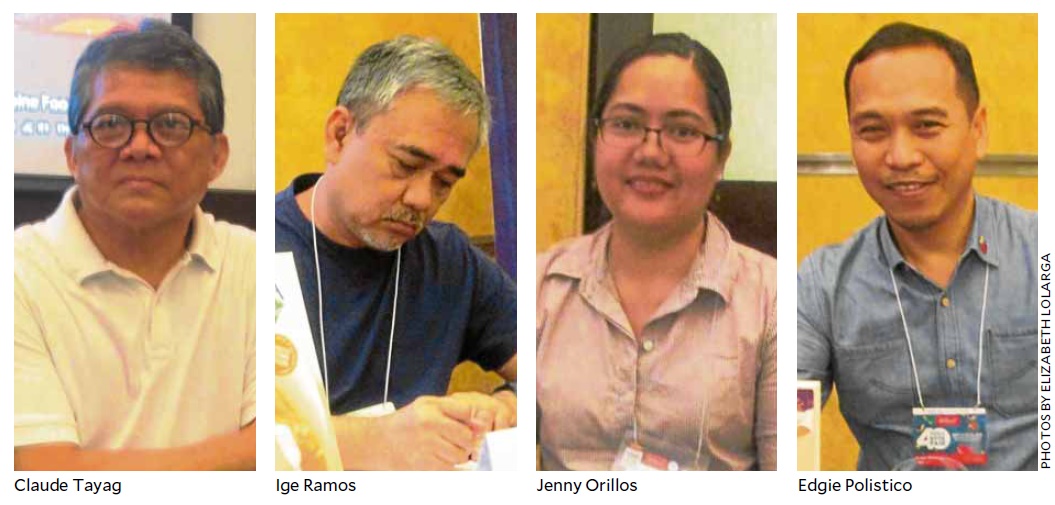
Food may be considered a subject relegated to the lifestyle or leisure section. But with a rice shortage that requires importation of this staple and as rice fields are converted into subdivisions, food has acquired a political bent.
In the panel discussion on “Food and Words: Serving Our Filipino Culinary History” at the recent Philippine Readers and Writers Festival at Raffles Hotel in Makati, Edgie Polistico, author of “Philippine Food, Cooking and Dining Dictionary,” the first such book in the country, recalled his impoverished childhood when he would help his mother sell kangkong so that they could eat and buy gas for electricity.
Later, in the quest to improve his written and spoken English, he traveled all over the Philippines to collect food terms in various languages, which he would translate into English.
He said a dictionary was a useful literary reference that “helps preserve language, conserve language and heritage” and act as an “inventory of culinary treasures, leading to the discovery of the unexplored and unknown.”
To be a lexicographer, he added, required “will and willingness” and acting like a criminal investigator or an investigative journalist.
The job also required sampling food and documenting it in words and pictures because “you can’t memorize everything.”
He went by the adage, “The spoken word flies, but the written word remains.”
Jenny Orillos, author of “Food Journal” and a grand-prize winner of the Doreen Fernandez food-writing contest, said she used primary and secondary resources in her research apart from memory and taste.
She added that the wonderful thing about food writing was “we get to taste what we write about.”
She quoted Janet Theophano, author of “Eat My Words: Reading Women’s Lives Through the Cookbooks They Wrote,” as writing, “The knowledge contained in cookbooks transcends generations.”
Orillos said, “Food becomes more meaningful if it is written about.” She advised young or beginner writers to “write down recipes, thoughts on food. To remember is to value your food.”
In her private journal, she kept records of her baking failures and mistakes, the prices of ingredients like butter which are always going up, and even pasted labels of baking advertisements. She would also sketch her ideas for plating dishes.
A journal like hers could also serve as health and nutrition planner so a keeper could watch out what he/she eats. She provided writing prompts in her “Food Journal” so the user could find creative ways to express himself or herself.
A journal like this serves as “a personal artifact intended for yourself and your family,” Orillos continued. She quoted cookbook author Tamar Adler: “When there is no narrative history, a recipe is the closest one family can come.”
Chef and visual artist Claude Tayag, one of six authors of the best-selling “Kulinarya,” described himself as a “chaser of flavors.” He said the defining flavor of Filipino cuisine is sourness which is found in such dishes as kilawin, Visayan sinigang, tinola, adobo, pickles, among many.
He said many parts of the country have the same dishes but with different names. He cited the bulalo in Batangas which is the puchero in Cebu, the kansi in Iloilo and the pakdol in Leyte.
He also clarified that “adobo isn’t a dish but a way of cooking.”
Ige Ramos, book designer and author of “Republic of Taste,” proposed the naming of the humble suman as the national dish. He said this was what fed the revolutionaries—it was filled with nutrients and easy to carry in one’s pocket.
From Batanes to Tawi-tawi the suman could be found in various permutations. It doesn’t choose a religion or ethnic affiliation. Ramos said, “Even the lumad (indigenous people) have this.”
He also said the suman played a role as sacred food in the Cordillera cañao, in the Muslim Ramadan and during Holy Week. It is even served in pamanhikan with two pieces of suman tightly bound to each other to make the man less shy about declaring his intention to marry his girlfriend.
Based on these data, Ramos said the suman deserved to be called the national food since it has become part of the Filipino’s consciousness. —CONTRIBUTED








































